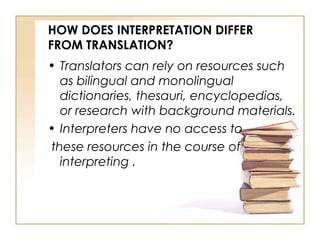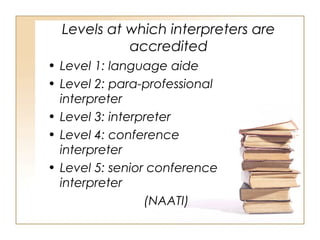- 2. What is interpreting?
“Interpreting consists of presenting in the
target language the exact meaning of what
is uttered in the source language either
simultaneously or consecutively, preserving
the tone of the speaker” (Mahmoodzadeh ,
1991, p.232).
- 3. What is interpreting?
• Interpreting work bridges the
“cultural and conceptual gaps”
between the participants in an
event (Jones, 1998, p.4)
- 4. Communication No language
barrier Mutual
understanding
- 5. HOW DOES INTERPRETATION DIFFER
FROM TRANSLATION?
• A translator studies written
material in one language and
renders it, also in written from,
into another language.
• An interpreter listens to a spoken
message and reproduces it in
oral form in another language.
- 6. HOW DOES INTERPRETATION DIFFER
FROM TRANSLATION?
• Translators can rely on resources such
as bilingual and monolingual
dictionaries, thesauri, encyclopedias,
or research with background materials.
• Interpreters have no access to
these resources in the course of
interpreting .
- 7. The process of interpreting
Understanding
The Input
Deciphering
Transference
C-1
C- 2
Output 1
Output 2
- 8. Consecutive interpretation
• The interpreter listens to a speech in
one language, takes notes, and then
renders it into another language.
• The time lapse between the speech
and its rendering varies greatly. It
usually lasts from anywhere between
one to fifteen minutes. In some special
occasions, the time lapse may be up
to half or one hour.
- 9. Simultaneous interpreting
• In simultaneous interpreting, the
interpreter sits in a sound-proof booth
renders the speech into another
language while listening to it.
• This mode of interpreting is used for
meetings with large numbers of
participants.
• Specialized equipment such as
headphones, earphones,
microphones, amplifiers are required.
- 10. Whispering interpretation
• This can be done as either consecutive
or simultaneous interpreting. The only
difference is that the interpreter does
not interpret for the whole audience in
the meeting.
• The interpreter sits next to or between
those participants who need the
interpretation and whispers the
interpretation to them or interprets
their messages.
- 11. Levels at which interpreters are
accredited
• Level 1: language aide
• Level 2: para-professional
interpreter
• Level 3: interpreter
• Level 4: conference
interpreter
• Level 5: senior conference
interpreter
(NAATI)
- 12. ???????????????????????????????
"Interpreting is easy. You just have to
know all the words."
- 13. Criteria for a GOOD interpreter
• Linguistic and cultural
knowledge
• Background knowledge
• Language and interpreting
skills
- 14. Codes of ethics
• Before the assignment
- be well-prepared
- improve one’s linguistic
competence
- be a clear speaker
- train memory
- have integrity & dignity
- 15. Codes of ethics
• During the assignment
- Be strictly punctual
- Introduce yourself
- Be impartial
- Be careful (speaking style)
- Take notes
- Listen actively &
- 16. Codes of ethics
• After the assignment
- self-criticism
- self-evaluation
















